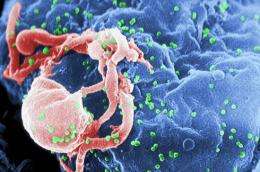Building A Handheld HIV Detector

Most Africans infected with HIV live in rural areas, where access to HIV testing has lagged behind the growing availability of HIV-fighting drugs.
Only clinics in big cities can afford the blood work equipment that allows doctors to monitor the disease’s progression and treat it early and effectively. Doctors in rural areas often prescribe treatment based only on the visible symptoms their patients show.
Responding to this need, researchers at California company Palo Alto Research Center have shrunk the laser technology inside large laboratory machines down to about the size of an iPod. Their cheap, handheld device promises to provide an immune system check-up on the spot and in less than 10 minutes.
"You need a device that a health worker can put into a backpack to reach the people in Africa or Asia," said Peter Kiesel, who presented his team's battery-powered prototype at a recent meeting of the American Physical Society in Portland, Ore.
The technology analyzes a small sample of blood drawn by a finger prick. Blood cells flow through a tiny channel, illuminated by a laser beam. A detector watches patterns in the light that bounces off the cells to identify them.
The detector looks for and counts CD4+ T cells, cells in the immune system that are killed by the HIV virus. The World Health Organization recommends that antiretroviral treatment begin when a patient's CD4 count drops below 250.
"The quality of their test is great," said researcher Bernhard Weigl of PATH, a non-profit reviewing a variety of CD4 testing technologies. "If you look at their graph, it pretty much looked like the graph you would get from a big instrument."
PARC's prototype cost about $250 to build, a hundred times cheaper than the large flow cytometers currently in use. Still, getting it to market may prove challenging.
Kiesel is competing against a dozen other groups vying to fill the need for cheap, portable CD4 tests. Other technologies have been under development for years, including a half-dozen recent projects funded by the Bill and Melinda Gates Foundation that include disposable CD4 tester kits as easy to use as a home pregnancy test. Kiesler's laboratory-tested device is a couple of years behind these projects, some of which have been tested in the field in African countries.
None of these devices is currently on the market. Many have been redesigned several times in the quest for commercialization, including a device by the Austin-based biotech company LabNow, which had hoped to have its technology on the market by 2006.
In the end, Weigl suspects that health workers will use some combination of these approaches in the field. Detectors like the one at PARC, with a low cost per person tested, make sense for areas with many cases of HIV, said Weigl. But disposable kits, which cost less initially and require no maintenance, may be a good solution for remote areas with fewer cases.
"I would be surprised if the first technologies aren't out by 2012," said Weigl. "The market is big; you're looking at many millions of users that have to get checked up every few months."
Provided by Inside Science News Service














